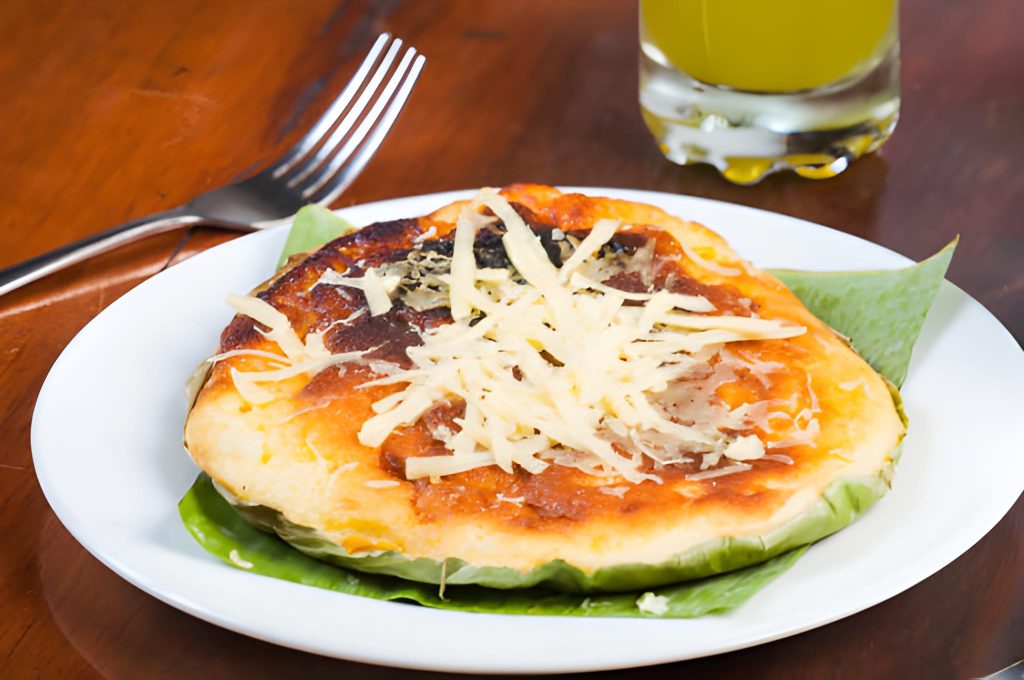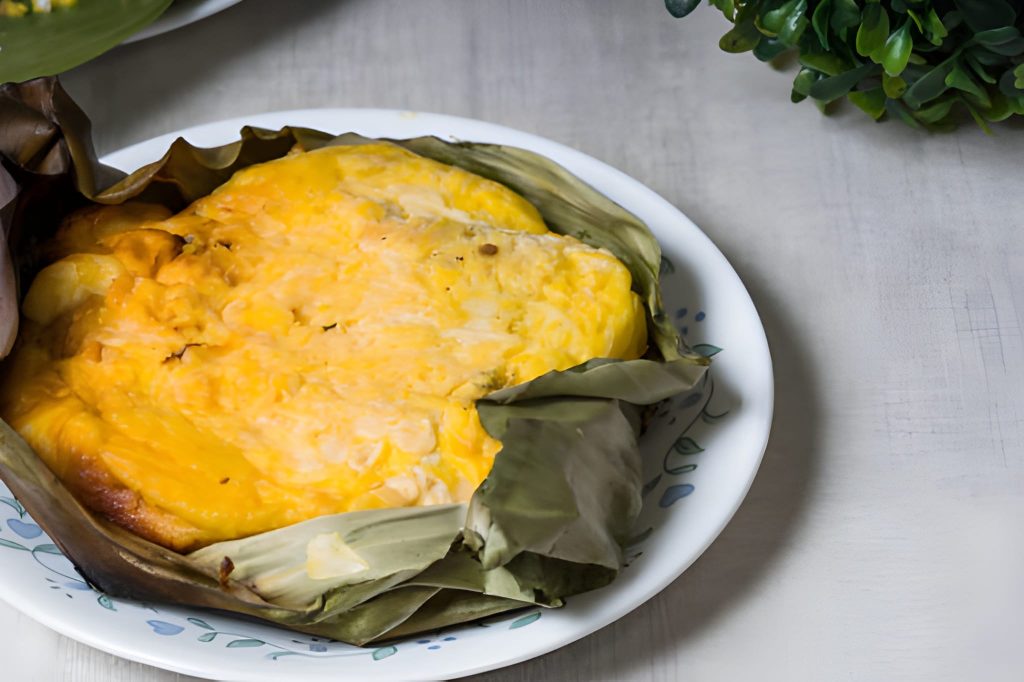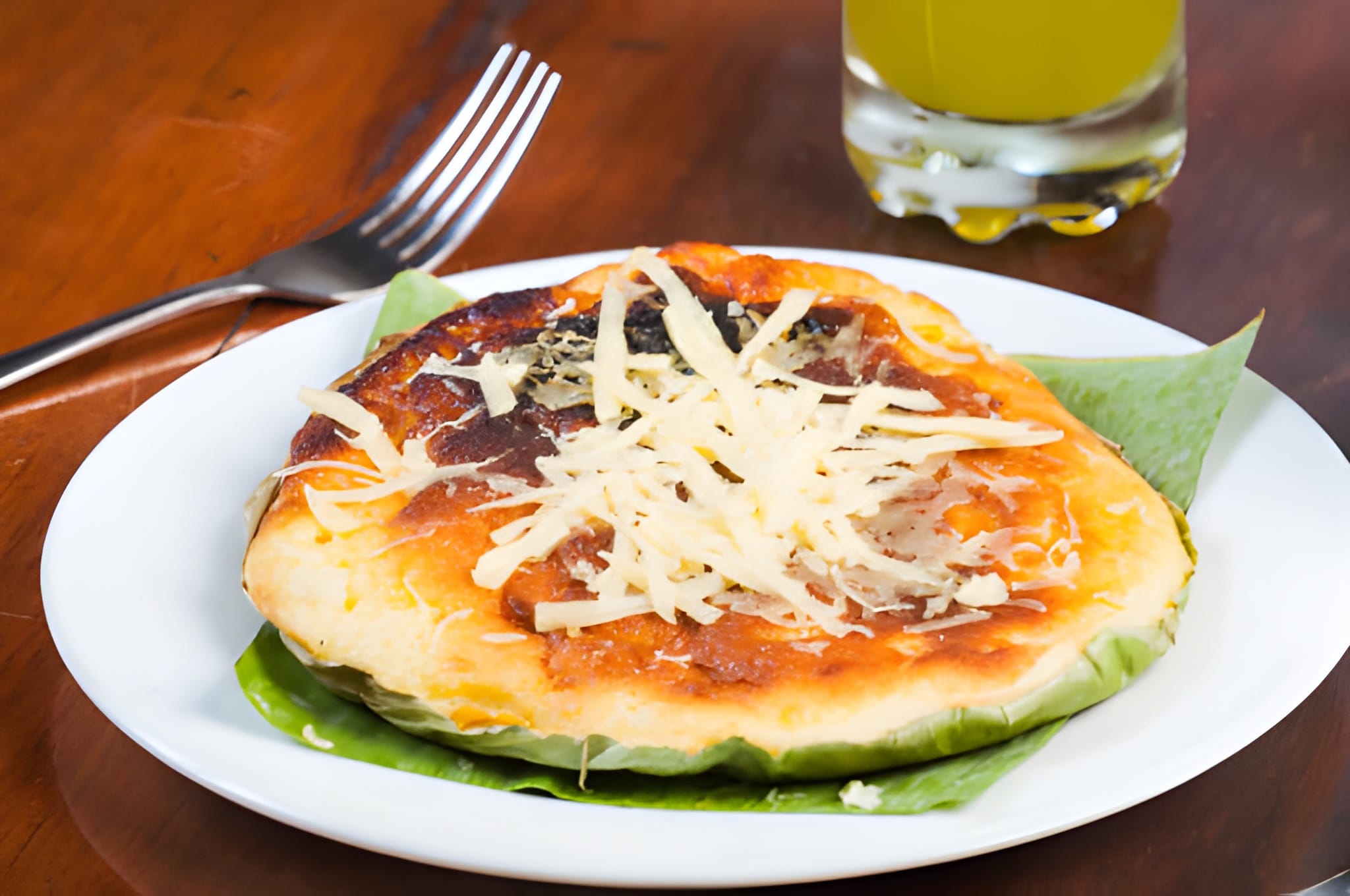Bibingka Recipe
Soft, buttery, and fragrant, Bibingka is a beloved Filipino rice cake that instantly evokes the warmth of festive mornings and cozy gatherings. Baked in banana leaves for a rustic aroma, it combines the delicate sweetness of coconut and sugar with the creamy richness of cheese and salted egg. Each slice offers a gentle balance of sweet and savory — a comforting reminder of tradition and togetherness.

Ingredient Breakdown
Every ingredient in Bibingka plays a key role in creating its signature flavor and texture. Rice flour forms the foundation of the cake, giving it that characteristic soft yet slightly chewy texture that sets it apart from regular baked goods. The combination of coconut milk and fresh milk provides richness and depth, adding a gentle creaminess to the batter. Butter and sugar give the cake a tender crumb and golden hue, while eggs lend structure and a light, fluffy rise.
The toppings bring another layer of flavor. Salted duck egg introduces a touch of savoriness that complements the sweetness of the cake, while grated cheese adds a creamy, slightly salty contrast. The finishing touch — a brush of butter and a sprinkle of freshly grated coconut — adds aroma, texture, and a delightful tropical finish. Wrapping the pan with banana leaves enhances everything with a faint smoky fragrance, making this simple rice cake extraordinary.
Step-by-Step Preparation Guide
Preparing the banana leaves is the first step to perfecting Bibingka. Gently heating them over an open flame softens their fibers, making them pliable enough to line the baking pan without tearing. This step also releases their natural oils, infusing the cake with a subtle, earthy aroma as it bakes.
The batter begins with creaming butter and sugar until light and fluffy — a process that gives the cake its tender texture. Eggs are added one by one, ensuring the mixture remains smooth and cohesive. Once combined, the dry ingredients — rice flour, baking powder, and salt — are gradually folded in to form the base. Alternating the addition of coconut milk and fresh milk ensures an even blend, resulting in a silky batter that’s rich but not too heavy.
Once the batter is poured into the banana leaf-lined pan, it’s baked just until the surface begins to firm up. This first bake sets the structure, making it ready to hold the toppings. Slices of salted duck egg are carefully arranged across the surface, followed by a generous layer of grated cheese. The cake is then returned to the oven for its final bake, where the top transforms into a golden crust — slightly caramelized, tender beneath, and perfectly fragrant.
When it emerges from the oven, a quick brush of melted butter gives the top a glossy sheen, while a sprinkle of grated coconut adds freshness and texture. Served warm, the soft interior and subtly crisp edges create an irresistible contrast in every bite.

Recipe Tips & Frequently Asked Questions
Use pre-heated banana leaves to prevent tearing and to infuse their natural aroma into the cake.
Warming the leaves helps them become flexible and easier to work with.
Ensure all wet ingredients are at room temperature for a smoother batter.
This prevents the butter from curdling and ensures an even mix.
Adjust sugar levels depending on preference — Bibingka can be mildly sweet or dessert-sweet.
Taste the batter before baking for balance.
Bake in the center of the oven for even heat distribution and a soft, fluffy center.
Uneven heat can cause overbrowning or dryness.
For a richer flavor, replace some fresh milk with evaporated milk or add a teaspoon of vanilla extract.
It enhances the aroma and creaminess.
Can I use all-purpose flour instead of rice flour?
Not recommended — rice flour gives Bibingka its signature soft, chewy texture.
What if I don’t have banana leaves?
Use parchment paper as a substitute; though it lacks the smoky aroma, it works perfectly well.
Can I use coconut cream instead of coconut milk?
Yes, but dilute it slightly with water to maintain the right consistency.
How do I know when the Bibingka is done baking?
The top should turn golden brown, and a toothpick inserted in the center should come out clean.
Can it be made ahead?
Yes, store in an airtight container and reheat gently in the oven before serving to restore its softness.
What to Serve With This Recipe
Bibingka pairs wonderfully with warm beverages like hot chocolate, brewed coffee, or salabat (ginger tea), each complementing its rich coconut flavor. It’s often enjoyed alongside other Filipino treats like puto bumbong or kutsinta, especially during the Christmas season. For an added touch of indulgence, serve it with melted butter and extra grated coconut on the side. It also makes a comforting breakfast or mid-afternoon snack, offering the perfect balance of sweetness and nostalgia.
Creative Variations
Add your own twist by layering the batter with macapuno strings or a swirl of ube halaya before baking for added sweetness and color. If you prefer a more savory touch, sprinkle extra cheese on top before the final bake. Using Edam cheese gives a creamier texture, while mozzarella melts into gooey perfection. For a modern take, bake the mixture in smaller molds or muffin tins for individual servings — perfect for gifting or holiday gatherings.
Bibingka is more than just a rice cake; it’s a comforting reminder of Filipino tradition and the joy of shared meals. Its delicate balance of sweet, salty, and creamy flavors, paired with the aroma of freshly baked banana leaves, makes it a timeless favorite. Whether enjoyed during the holidays or on an ordinary morning, Bibingka brings a taste of home with every warm, buttery bite.

Ingredients
1 cup rice flour
3 pieces raw eggs
½ cup granulated sugar
3 tablespoons butter
1 cup coconut milk
¼ cup fresh milk
2½ teaspoons baking powder
⅛ teaspoon salt
1 piece salted duck egg, sliced
½ cup grated cheese
¼ cup grated coconut
Pre-cut banana leaves
Instructions
Preheat your oven to 375°F (190°C) and prepare a round cake pan or baking dish by lining it with pre-cut banana leaves. Lightly heat the leaves over an open flame or stove burner for a few seconds to make them pliable and release their natural aroma before placing them in the pan.
In a large mixing bowl, combine the rice flour, baking powder, and salt. Whisk together until evenly blended, then set aside. In a separate bowl, cream the butter until soft and smooth. Gradually add the sugar while whisking continuously until the mixture becomes light and fluffy.
Crack in the eggs, one at a time, whisking well after each addition to fully incorporate. Slowly fold in the dry mixture of rice flour, salt, and baking powder, stirring gently until just combined.
Pour in the coconut milk and fresh milk alternately while whisking to form a smooth, thick batter. Continue mixing for another 1 to 2 minutes to ensure the ingredients are fully integrated.
Pour the prepared batter into the banana leaf-lined pan, spreading it evenly. Place the pan in the preheated oven and bake for 15 minutes, or until the surface begins to set. Remove the pan from the oven, and while still hot, arrange the slices of salted duck egg on top, followed by a generous sprinkle of grated cheese.
Return the pan to the oven and bake for an additional 15 to 20 minutes, or until the top turns a beautiful golden brown and a toothpick inserted into the center comes out clean. Once baked, take the bibingka out of the oven and allow it to cool slightly.
Brush the surface with melted butter for a glossy finish and top with freshly grated coconut before serving. Enjoy this soft, aromatic Filipino rice cake warm — perfect with a cup of coffee or hot chocolate.

Bibingka Recipe
Ingredients
- 1 cup rice flour
- 3 pieces raw eggs
- ½ cup granulated sugar
- 3 tablespoons butter
- 1 cup coconut milk
- ¼ cup fresh milk
- 2½ teaspoons baking powder
- ⅛ teaspoon salt
- 1 piece salted duck egg sliced
- ½ cup grated cheese
- ¼ cup grated coconut
- Pre-cut banana leaves
Instructions
- Preheat your oven to 375°F (190°C) and prepare a round cake pan or baking dish by lining it with pre-cut banana leaves. Lightly heat the leaves over an open flame or stove burner for a few seconds to make them pliable and release their natural aroma before placing them in the pan.
- In a large mixing bowl, combine the rice flour, baking powder, and salt. Whisk together until evenly blended, then set aside. In a separate bowl, cream the butter until soft and smooth. Gradually add the sugar while whisking continuously until the mixture becomes light and fluffy.
- Crack in the eggs, one at a time, whisking well after each addition to fully incorporate. Slowly fold in the dry mixture of rice flour, salt, and baking powder, stirring gently until just combined.
- Pour in the coconut milk and fresh milk alternately while whisking to form a smooth, thick batter. Continue mixing for another 1 to 2 minutes to ensure the ingredients are fully integrated.
- Pour the prepared batter into the banana leaf-lined pan, spreading it evenly. Place the pan in the preheated oven and bake for 15 minutes, or until the surface begins to set. Remove the pan from the oven, and while still hot, arrange the slices of salted duck egg on top, followed by a generous sprinkle of grated cheese.
- Return the pan to the oven and bake for an additional 15 to 20 minutes, or until the top turns a beautiful golden brown and a toothpick inserted into the center comes out clean. Once baked, take the bibingka out of the oven and allow it to cool slightly.
- Brush the surface with melted butter for a glossy finish and top with freshly grated coconut before serving. Enjoy this soft, aromatic Filipino rice cake warm — perfect with a cup of coffee or hot chocolate.

